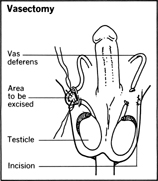Family Planning - Permanent birth control
Permanent birth control is obtained surgically. It is usually nonreversible. Surgical sterilization is available to both women and men.

Tubal Ligation
Tubal ligation is the surgical blocking of the fallopian tubes. The fallopian tubes transport the egg from the ovary to the uterus. By blocking the path that the egg travels, the egg is no longer capable of making contact with the sperm. Tubal ligation is done by cutting, tying, banding, cauterizing, or removing a section of each tube so the path is no longer continuous. Depending on the surgical method used to block the tube, the ability to reverse the procedure (should you decide later to have children) may be nearly impossible. Also depending on the method used to tie off the tubes, the number of women who become pregnant after a tubal ligation is, at the highest, 2 in 1000.
Tubal ligation can be done immediately following childbirth, if the doctor is briefed on the decision well in advance of the delivery. It can also be done by scheduled surgery at any time. Fifteen percent of all women over the age of 45 have elected to have a tubal ligation.
Hysterectomy
Hysterectomy is the removal of the uterus and, perhaps, the cervix. This procedure is completely irreversible. Chances of pregnancy following the procedure are none.
A subtotal hysterectomy is the removal of the uterus, leaving the cervix, fallopian tubes, and ovaries in place. A total hysterectomy is the removal of the cervix as well as the uterus. Oophorectomy and ovariectomy are both used to describe the surgical removal of one or both of the ovaries. Ovariohysterectomy is the removal of the ovaries, fallopian tubes, and uterus. The quantity of tissue removed will be determined by the patient and the doctor, based on the reasons for the operation. For removal of cancerous tissue, all the organs may need to be removed. For sterilization, only a subtotal hysterectomy may be necessary.
Hysterectomies have become increasingly used to correct problems that may be remedied by medication, or which may be temporary in nature and not warrant surgery. To recommend a hysterectomy solely for birth control is unusual. It should only be done in cases where tubal ligation is not sufficient in correcting problems, or where some underlying physical problems require surgery. Although hysterectomies are common, they are still considered major surgery and should be approached as such, by both the doctor and the patient. Recoveries can take six weeks or longer.
Vasectomy
Vasectomy is sterilization of the male by cutting the vas deferens, the tubes that transport the sperm. The surgery is normally performed in the doctor's office with local anesthesia. Incisions are made either on each side of the scrotum or on the center mid-line of the scrotum. The tubes are then cut, and tied or cauterized on each end. Pain following the procedure is usually responsive to non-aspirin painkillers. Heavy lifting or strenuous exercise should be avoided for a week.
Vasovasotomy is the surgical procedure that attempts to reconnect the vas deferens after a vasectomy. This operation is done for men wishing to reverse the surgical sterilization. Success at this procedure can vary from 30 to 75 percent, depending on the type of initial sterilization procedures, and on the skill of the surgeon in reconnection of the tubes.

